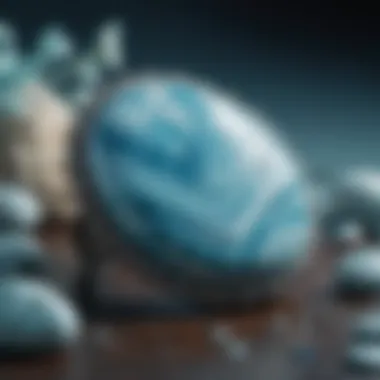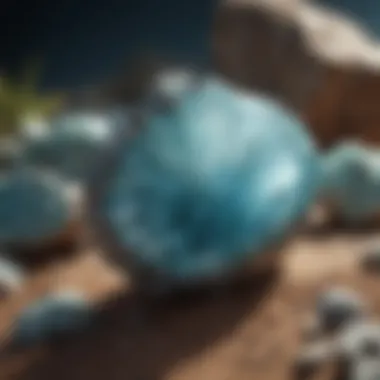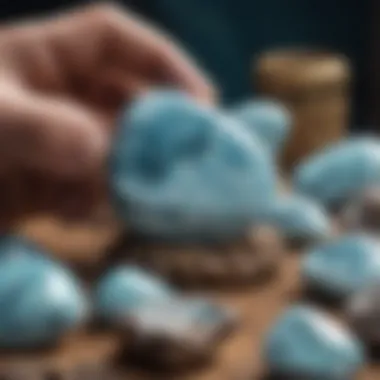Understanding Larimar: Journey of a Unique Gemstone


Intro
Larimar, a striking blue gemstone with a unique, crystalline charm, is a treasure of the Dominican Republic. Known for its stunning ocean hues, it captivates both collectors and casual admirers alike. In this article, we will explore its formation, historical significance, and its role in jewelry design. The journey of Larimar is not just a story of geological processes, but also of cultural richness and metaphysical allure.
While many are familiar with various gemstones, Larimar stands apart with a fascinating origin that intertwines nature and humanity. As we peel back the layers of its history and beauty, readers will gain an understanding of what makes this gemstone truly special. Our discussion will navigate through Larimar's geological processes, its significance in various cultures, and offer guidance for identifying genuine pieces.
Importantly, Larimar isn't just another pretty stone. Its metaphysical properties allure those interested in spirituality and wellness, linking it to serenity and healing. But the intrigue doesn’t stop there. The gemstone's value in the market means it’s vital for collectors and enthusiasts to recognize authentic pieces and understand what drives its pricing.
Let's embark on this expedition through Larimar's mesmerizing journey, starting with an overview of gemstones in general, moving toward the distinct characteristics that set Larimar apart.
Gemstone Overview
Definition of Gemstones
Gemstones are minerals, rocks, or organic materials that are cut, polished, and used in jewelry and other decorative items. Their beauty, durability, and rarity contribute to their status. Usually, gemstones are graded based on their clarity, color, cut, and carat weight, which come into play significantly when determining a stone's value.
Classification of Gemstones
Gemstones fall into two primary categories: precious and semi-precious. Traditionally, the so-called precious gemstones include diamonds, rubies, emeralds, and sapphires. All other gemstones, including Larimar, are considered semi-precious. Still, this classification doesn’t downplay the stunning beauty and uniqueness of Larimar. The color of Larimar, reminiscent of tranquil Caribbean waters, sets it aside visually and creatively.
Historical Significance
Origins of Gemstone Use
The use of gemstones dates back thousands of years, with ancient civilizations often attributing spiritual or medicinal properties to them. Larimar, however, is a relatively newcomer in the gemstone world. Discovered in the late 20th century, its origins trace back to a 1974 finding by Miguel Méndez and his partner, who stumbled upon it while wandering the beaches of the Dominican Republic.
Cultural Insights: Gemstones in Ancient Civilizations
Throughout history, gemstones have held deep meanings and associations in various cultures. In ancient Egypt, lapis lazuli was treasured for its deep blue color and believed to offer protection. Similarly, Larimar is viewed as a conduit for communication and calming energy in some traditions, symbolizing peace and clarity.
"Larimar is not just a beautifully striking stone; it's a testament to the earth's ability to produce natural wonders that resonate on a deeper level with human experience."
Its rarity reflects in its name, which originates from the Spanish word for sea, "mar," and the name of the discoverer's daughter, "Larissa." This connection of personal, natural, and cultural heritage enhances its allure.
This discussion introduces the broad scope of Larimar’s significance. Understanding these elements not only enhances appreciation for the stone itself but also the intricate tapestry of humanity's relationship with gemstones. Next, we’ll dive deeper into its geological formation and specific characteristics.
Prolusion to Larimar
When it comes to gemstones that hold both beauty and significance, Larimar stands out like a lighthouse in the fog. This captivating blue stone, found only in the Dominican Republic, has a story that stretches beyond its aesthetic allure. Understanding Larimar is not merely about appreciating its vibrant hues; it's about grasping the delicate interplay of geology, history, and culture that shapes its identity.
Defining Larimar
Larimar, a variety of pectolite, sports shades that range from soft sky blue to deep ocean depths. What sets it apart from other stones is its unique color, caused by the presence of copper and rare geological conditions. Often resembling the sea and sky, it captures a tranquil essence that many collectors find difficult to resist. Its intrinsic value lies not only in its visual appeal but also in the rich stories and beliefs associated with it.
The name itself combines "Lari" from the indigenous word for the area—Barahona—and "mar," which means sea in Spanish, lending it a poetic quality. Collectors and enthusiasts are drawn to Larimar not just for its looks but for what it represents — a connection to nature, serenity, and cultural heritage.
Historical Context
Diving into the historical context of Larimar adds layers to its allure. The discovery of this gemstone is relatively recent, dating back to the 1970s when a Dominican named Miguel Méndez stumbled upon it while exploring the coastal areas of the Dominican Republic. Although the stone existed long before that moment, it wasn’t until then that it garnered recognition.
Prior to its formal discovery, indigenous peoples of the Dominican Republic held beliefs about gemstones and their powers. While Larimar wasn't known in the ways other stones were, its unique blue presence would fit seamlessly into their rich tapestry of spirituality and tradition. Furthermore, the gemstone's emergence has played an essential role in the economic development of local communities, providing employment and a sustainable livelihood to many artisans.


Understanding the layers of history behind Larimar reveals how its significance extends far beyond simple commerce. The connection to the land, culture, and even community welfare imbues the gemstone with relevance that continues to resonate today.
"A gemstone like Larimar is not just a trinket, it's a piece of history that reflects the spirit of a people."
As we peel back the layers of Larimar’s story, it becomes clear that there’s more beneath the surface than just a pretty stone. From its rare formation to the cultural significance it holds, Larimar invites intrigue and admiration from those who have the pleasure of encountering it.
Origins and Formation
The journey of Larimar begins from the Earth itself, encapsulating an intricate tale of geology, transformation, and rarity. Understanding the origins and formation of this captivating blue gemstone is critical, as it not only highlights its unique characteristics but also affirms its significance in the world of gemstones. This section dives into the geological background of Larimar, explores its crystal structure, and uncovers the locations where it is mined. By grasping these elements, enthusiasts and collectors will appreciate not just the beauty of Larimar, but the remarkable natural processes that keep it grounded in the Dominican Republic.
Geological Background
Larimar has a genesis deeply rooted in volcanic activity, making its occurrence rare and intriguing. Formed roughly 60 million years back, the stone originates in the area of the Sierra de Baoruco mountains. When volcanic eruptions took place, they released fluids rich in particular minerals, which eventually crystallize over time as they cool and solidify. Larimar is essentially a variety of pectolite, dotted with copper, a characteristic that contributes to its stunning blue hue.
The formation of Larimar underscores the environmental forces at play. The heat and pressure beneath the Earth's crust have conspired to create a striking mineral that is not just a visual gem but also a geological marvel. The scientific processes that lead to Larimar's birth make it a point of conversation among geologists and mineral enthusiasts alike, emphasizing its rarity in comparison to more prevalent gemstones.
Crystal Structure
The crystal makeup of Larimar is both fascinating and complex. Uniquely, it exhibits a fibrous structure interweaving of monoclinic crystals. This fibrous arrangement imparts a unique luster to the stone and frequently creates swirling patterns that mimic the color of the Caribbean Sea. The blue coloration, attributed to the presence of copper, can range from light sky blue to deep ocean hues; this variability often influences desirability in the market.
Moreover, the composition of Larimar can affect its properties, such as clarity and durability. Understanding the nuances of its crystal structure can elevate one’s appreciation not just for its aesthetic qualities but for its geological significance. A stone that embodies the heart of its location, Larimar represents a beautiful intersection between nature's artistry and scientific wonder.
Mining Locations
Larimar is mined primarily in the Dominican Republic, specifically within the Parque Nacional Sierra de Bahoruco region. This prime spot is where the geological conditions align perfectly for Larimar's formation. The rarity of the stone arises not only from its formation but also from the limited mining locations. Local miners have developed small-scale operations, extracting the stone through environmentally conscious practices.
Navigating the intricacies of Larimar mining requires understanding the community behind it. Many miners are aware of the gemstone's rising popularity and, consequently, the need for ethical sourcing. Since Larimar is found in only one geographical location, its extraction must be handled with care to preserve both the natural environment and the local economy. Cultivating relationships with the community also adds a layer of ethical consumerism for collectors, who can ensure their stones are sourced responsibly.
"Understanding where Larimar comes from not only enhances its value but reinforces the bond between the gem and its cultural roots."
In summary, investigating the origins and formation of Larimar reveals much about this gemstone's identity; it highlights its beauty and reinforces the intrinsic values that come from its geological and cultural heritage.
Physical Characteristics
The physical characteristics of Larimar are key factors that define its allure and value in the gemstone market. This segment focuses on three vital aspects: color variations, clarity and transparency, and durability and hardness. Each of these elements contributes to the charm and desirability of Larimar not just among collectors but also among jewelry designers. They are essential considerations for anyone looking to invest in, appreciate, or utilize this unique gemstone. Understanding these characteristics helps enthusiasts discern quality and authenticity, ensuring they make well-informed decisions.
Color Variations
Larimar is renowned for its breathtaking spectrum of blue hues. From light sky blue to a deeper ocean tone, the color variations are influenced by its volcanic origins and the presence of copper. Some stones exhibit white or greenish inclusions, which can enhance their aesthetic appeal, making each piece truly one of a kind. The color range is often classified as follows:
- Sky Blue: Lightest shade, simple yet stunning.
- Ocean Blue: Richer tones, reminiscent of deep water.
- Blues with White Patterns: Striking contrast, often seen in high-quality stones.
"The rich color of Larimar can genuinely capture the essence of the sea, making each piece a wearable piece of nature."
Collectors often find themselves drawn to specific shades or patterns, sometimes forming attachments based on personal resonance or aesthetic preference. Designers favor these variations as they offer flexibility in creating stunning jewelry pieces that can cater to diverse tastes.
Clarity and Transparency
Clarity plays an essential role in Larimar’s overall quality. The best specimens are semi-translucent, allowing light to enhance their colors beautifully. While inclusions are not typically desired in gemstones, in Larimar, some inclusions can add depth and character. When assessing clarity, consider these aspects:
- Transparency Levels: Ranges from opaque to translucent; higher clarity enhances value.
- Inclusion Types: Some may find inclusion patterns adding to the story of the stone.
- Luster: A smooth, polished surface that catches light certainly elevates the visual experience.


In the context of jewelry making, stones with higher clarity are often preferred, as they allow for a more radiant final product. But, even those with slight inclusions hold beauty; they’re simply reflections of the stone’s unique journey through time.
Durability and Hardness
When it comes to jewelry, durability is an important consideration. Larimar scores about 4.5 to 5 on the Mohs scale of mineral hardness, which places it in a delicate category compared to sturdier gemstones like diamonds and rubies. This characteristic means that:
- Care is Crucial: Avoid exposure to harsh chemicals, as these can weaken the stone or dull its surface.
- Suitable Settings: Consider protective designs when setting Larimar in rings or bracelets.
- Wear with Caution: Best suited for occasional wear rather than everyday use.
Despite its relative softness, Larimar remains a cherished gem due to its stunning visuals. Enthusiasts should understand that while it may require more care than some stones, it also brings forth an unmatched beauty that is hard to rival.
In summary, the physical characteristics of Larimar—the mesmerizing color variations, intriguing clarity, and modest durability—are what make this gemstone a fascinating subject for study and appreciation. Whether you're a collector or designer, these elements are pivotal in understanding what makes Larimar truly special.
Cultural Impact
Understanding the cultural impact of Larimar sheds light on the layers of significance this gemstone holds, particularly in its native Dominican Republic. Given its unique beauty and history, Larimar is more than just a geological curiosity; it embodies a rich narrative that intertwines with the identity of the local communities.
Symbolism in the Dominican Republic
In the Dominican Republic, Larimar is often seen as a symbol of hope and tranquility. Its captivating blue hue, reminiscent of the Caribbean Sea, is associated with the serenity and beauty of the island. Many locals view Larimar as a gift from nature, a tangible link between their culture and the environment. It's often believed that the gemstone brings peaceful energy, elevating its status to that of a talisman for emotional healing.
Historically, Larimar has also become intertwined with Dominican cultural pride. The stone's discovery in the late 1970s initiated a revival of indigenous craftsmanship among artisans, many of whom specialize in transforming Larimar into jewelry and decorative items. Thus, it serves not just as an expressive medium for creativity, but as a vehicle for preserving and promoting local artistic traditions.
"Larimar is like the soul of the Dominican people—deep, beautiful, and full of stories."
— Local Artisan
As it continues to gain international recognition, Larimar has played a crucial role in the Dominican Republic's cultural exports. The gemstone has become synonymous with Dominican artistry, appearing in jewelry materials that tourists and collectors cherish. This synergy between Larimar and Dominican culture emphasizes the importance of preserving local heritage while fostering economic opportunity.
Larimar in Art and Craft
The presence of Larimar in art and crafts is a reflection of both traditional and contemporary Dominican artistry. Artisans employ various techniques, from hand-carving to modern jewelry-making processes, to showcase the stone's vibrant colors and intricate patterns.
- Handcrafted Jewelry: Each piece of Larimar jewelry usually tells a story, whether it's the design inspired by local folklore or the combination of other materials like silver or gold. Many artisans rely on their cultural backgrounds to infuse their artistic vision into every design, creating unique pieces that resonate with buyers.
- Cultural Artifacts: Beyond jewelry, Larimar is integrated into numerous crafts, such as sculptures and decorative pieces. These artifacts often serve educational purposes, educating viewers about the geological and cultural significance of Larimar.
Through these artistic endeavors, Larimar not only serves aesthetic purposes but also functions as a cultural ambassador, connecting a worldwide audience to the stories, values, and traditions of the Dominican people. Its growing popularity invites ongoing dialogue about sustainability, authenticity, and the role of local craftsmanship in a globalized market.
Metaphysical Properties
The metaphysical properties of Larimar beckon to many who seek a deeper understanding of this striking blue gemstone. While it is undoubtedly celebrated for its aesthetic appeal, there is a growing fascination with the alleged spiritual benefits it offers. From healing attributes to emotional support, Larimar is often associated with a variety of positive traits.
Healing Attributes
Many gemstone enthusiasts and healers tout Larimar as a powerful stone for physical and spiritual healing. Its soothing blue tone is thought to resonate with the energy of the sea, promoting tranquility and relaxation. One notable claim is that Larimar can help alleviate stress and tension, offering a calming effect that is believed to aid in the connection between mind and body. Here are some common aspects attributed to its healing properties:
- Throat Chakra Alignment: It is said to enhance communication and facilitate self-expression, especially in situations where emotions run high.
- Physical Healing Support: Some users report that it helps with ailments such as headaches and respiratory issues, like asthma. This gemstone is sometimes called a stone of “communication” for its ability to aid those who struggle with expressing their feelings.
- Energy Cleansing: Larimar is believed to cleanse negative energies and promote a sense of renewal. This makes it a popular choice for those looking to transform their emotional and spiritual well-being.
"Larimar’s energy is like a soft wave of warmth, washing away negativity and leaving behind calm and clarity."
Emotional Benefits
When it comes to emotional well-being, Larimar is often celebrated for its ability to stabilize and balance feelings. The calming energy it is reported to emanate can support individuals through difficult emotional states, fostering a sense of peace and acceptance. Here’s what one might experience emotionally when working with Larimar:
- Promoting Inner Peace: Its serene color can foster an environment of tranquility, helping to ease fears and anxieties. Individuals may find that it creates a safe space for emotional release.
- Improving Relationships: By enhancing communication, Larimar may bolster connections with others, providing insight and improving understanding in relationships. It’s often sought after for its ability to support clarity in discussions and reduce conflict.
- Encouraging Self-Discovery: Many users claim that it helps them dive deep into their subconscious, promoting healing from past traumas and emotional wounds. This journey of self-discovery can spark personal transformation, leading to greater self-acceptance.


In sum, Larimar's metaphysical properties provide a canvas for exploration into both emotional and physical realms. While personal experiences may vary, many find profound resonance with the energies this gemstone is said to harbor.
Application in Jewelry
Larimar, with its captivating hues reminiscent of the ocean, holds a significant place in the realm of jewelry application. It’s not just another pretty face in the world of gemstones; it's a narrative woven from the threads of history, geology, and cultural significance. The inclusion of Larimar in jewelry pieces elevates aesthetics while bringing depth to the story behind the object itself. This section will explore the design inspirations and practical care that go into crafting jewelry with this stunning gem, discussing why it stands out in the market.
Design Inspirations
When it comes to designing jewelry featuring Larimar, the creativity knows no bounds. The soft blues and greens of the stone provide a canvas for unique artistic expression. Many jewelers draw inspiration from the natural world, mirroring the oceanic themes that Larimar embodies. For instance:
- Ocean Inspired Designs: Jewelry pieces often mimic the ripples and waves of the sea, with flowing lines that echo the gemstone’s fluidity.
- Cultural Elements: Some artisans incorporate motifs from the Dominican Republic, blending the gemstone's beauty with cultural heritage. Think of pieces adorned with tropical flora or indigenous patterns.
- Contrast with Other Gems: Larimar pairs effortlessly with metals like silver or gold, creating striking contrasts that highlight its blue tones. Designers might use complementary stones, such as clear quartz or even colorful dichroic glass, to further enhance the visual impact.
The popularity of Larimar also stems from its versatility. Whether set in a bold statement piece like a pendant or delicately woven into a pair of earrings, it adapts to the aesthetic preferences of diverse customers. This adaptability makes it ideal for those seeking something uniquely personal in their jewelry collection.
Care and Maintenance
Jewelry adorned with Larimar, while beautiful, requires a bit of TLC to maintain its brilliance. It's a delicate gemstone, softer than many others and should be treated with care. Here are some essential tips to ensure that your Larimar pieces remain stunning:
- Cleaning: Use only lukewarm water and a mild soap solution. Avoid harsh chemicals or ultrasonic cleaners as they tarnish the stone.
- Storage: Keep your Larimar jewelry in a soft pouch or lined box to avoid scratching. It’s advisable to store it separately from harder gemstones to prevent damage.
- Avoid Direct Sunlight: Extended exposure to sunlight may cause the color to fade over time. It’s prudent to store your pieces in a cool, dry place away from direct light.
In essence, jewelry made from Larimar not only enhances personal style but also connects wearers to the enchanting stories of the sea and the Dominican culture. Those who don the gem are holding a piece of history entwined with the beauty of nature, an appealing combination that resonates deeply with gemstone enthusiasts and collectors alike.
"Jewelry not only enhances our beauty, but it also tells our unique stories, making the piece of Larimar feel more like a cherished artifact than a mere accessory."
With the right care, Larimar can remain a cherished part of your collection for generations.
Market Insights
In the world of gemstones, understanding market dynamics is key for both buyers and sellers. Larimar stands out not just for its mesmerizing colors but also for its unique economic story. Knowing market insights can greatly enhance one’s purchasing decisions and investment strategies. This section will detail the value and pricing of Larimar, as well as the challenges associated with its authenticity.
Value and Pricing
The valuation of Larimar is a complex interplay of factors including quality, demand, and availability. Generally, the price of Larimar ranges from $10 to $100 per carat, depending on its clarity, color, and cut.
- Color Quality: The most sought-after Larimar displays a vibrant blue akin to the clear Caribbean waters. Stones with a more pronounced blue are often valued higher.
- Clarity: Higher clarity stones fetch better prices. Inclusions or mottling can lower the value significantly.
- Size and Cut: A well-cut, sizable stone commands a premium. Unique shapes or designs can also influence price.
When purchasing Larimar, always consider the source. A reputable dealer can provide a clearer understanding of the stone's market value.
"Knowing the market before diving in can save you a pretty penny in the long run."
Challenges in Authenticity
As Larimar gains popularity, concerns about authenticity become more prevalent. Unfortunately, the increase in demand has led to several challenges.
- Synthetic Variants: Some sellers may offer synthetic replacements, which mimic the appearance of Larimar but lack its unique properties.
- Misleading Descriptions: Not all vendors accurately describe their stones, leading potential buyers to unknowingly purchase lower-quality or fake stones.
- Limited Mining Locations: Since Larimar is predominantly found in the Dominican Republic, resources sold outside this area may require close scrutiny.
In navigating these challenges, it’s paramount to verify through reliable sources. Certificates of authenticity from reputable gemological institutes can offer peace of mind for collectors and enthusiasts alike.
Closure
In wrapping up our exploration of Larimar, it’s vital to reflect on not only the stone’s rich history and alluring beauty but also the myriad appreciations it garners from enthusiasts and collectors alike. This gemstone, with its mesmerizing hues reminiscent of the Caribbean sea, carries more than just aesthetic value; it encapsulates cultural significance, geological wonder, and personal meaning.
Summarizing the Essence of Larimar
Larimar stands as a testament to the profound intersection of nature and humanity. From its unique formation in the volcanic mountains of the Dominican Republic to the hands that craft it into exquisite jewelry, each piece of Larimar conveys a story. Collectors often find themselves drawn not merely to its physical properties but to its symbolic meanings and metaphysical attributes as well, which many believe offer emotional healing.
"A gemstone like Larimar becomes a personal talisman, often reflecting the hopes and dreams of its owner."
The market insights discussed earlier shed light on both the challenges and opportunities that come with purchasing this beautiful gem. Authenticity, as noted, emerges as a central concern for buyers. Awareness of its value and the intricacies involved in distinguishing genuine stones from imitations is crucial for anyone intent on adding Larimar to their collection.



